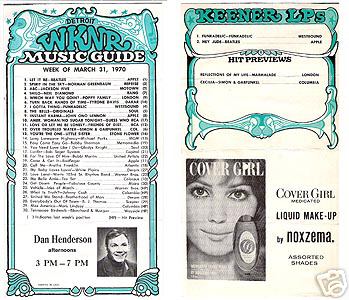 From the MCRFB news archive: 1970
From the MCRFB news archive: 1970
WKNR’s Broussard Makes Radio Programming Without Time Constraints While at Helm
DETROIT — It isn’t often you’ll see a radio station program director in a record store, let alone see one sitting there all day. And even less often you will see a program director there taking notes about what kind of people are buying what kind of records. Skip Broussard, a program director whose next job is to aid WKNR here and attempt to put it firmly into the ratings picture used information gained at record stores this way to built a pretty good success story in Knoxville at WKGN. He was involved in the same type of programming at WMPS, Memphis, until getting an offer for the Detroit job.

To gain a representative picture of the audience available in Memphis, Broussard surveyed record shops in all geographic locations of the city. “I found that in a area heavy populated with blacks, the stores would be selling some Beatles and other records by white artists. And, in a very posh area, the shop would be selling soul records. Some very high class whites were buying soul records especially high school kids and young adults of college age.
“There seemed to be a breaking down of the old barriers — at least in Memphis.”
Broussard spent at least one day each weekend for six weeks in local stores in Memphis. During the week, he sent his air personalities out to spend time in the record shops.
All of this data was translated into the station’s programming. Broussard admitted, “I was targeting a black and white audience. I was after the audience of the other pop station and the audience of WDIA, a soul station that has been No. 1 in Memphis for several years.”
The playlist under WMPS under Broussard’s direction became 50 per cent soul in nature, “but only the soul records that was selling to both white and black people. We were trying to avoid any ethnic image. If we could have gained both audiences, WMPS would have achieved giant ratings. And blacks listened longer so that would have helped ratings too.”
Research and Sales
WMPS based its playlist on the results of the in-store research, plus sales figures garnered by telephone and telephone requests from listeners. Each request over the phone was listed and identified by age. “Gradually, the black listeners grew as we added soul records,” Broussard said.
“This type of programming is a whole new untapped area. Many stations are afraid at the moment to play soul records — afraid it will drive off their white listeners. Bit I feel records don’t have to be considered black and white. Because black and white people are finally getting together. I can see it happening in the same degree that they’re digging each other’s music.
“The program director could play an extremely important role in racial harmony by giving both types of music exposure within the realm of good programming. When I get a black person requesting a record by a white, it makes me feel good. And the same goes for a white requesting a soul record.”
Broussard got his start in radio in 1961part-time working KSIG in Crowley, Louisiana, while attending the University of Southwest Louisiana at Lafayette. He later worked part-time at KALB in Alexandria, La., then became program director full time at KXKW, Lafayette while still attending school. In 1966, he joined WLCS in Baton Rouge , but after a year was called into the Army reserves for six months. Then he returned to WLCS for a year before joining WTIX in New Orleans as music director under program director Buzz Bennett. He was there two years and admitted he “learned a lot from Buzz Bennett during that two-year stint there.”
But after joining WKGN in Knoxville as program director, he took graduate courses in market research and the psychology of mass communications which also shaped his present theories on researching for programming.
“There are environmental factors in any market which stimulate and influence the people living there,” Broussard continued. “And these generally relate to music. In Memphis, there’s a heavy black population and it’s the home of the blues — these factors have influenced the whites towards the blues. A southern white animosity counteracts this slightly. But you’ll still find 50-60 percent of the records on WDIA’s playlist selling to whites, which would indicate some of their listeners are white. “WDIA,” he said, was playing such artists as the Beatles, Led Zeppelin, and Dusty Springfield at one time. I admire them for that. I don’t know who was responsible, but he was thinking big.”
An unusual factor about Memphis was that soul records companies provided poor record service to the pop stations, Broussard said. “Stax Records really didn’t work the white stations. Same with Motown Records. And its unfortunate. I wanted to play their records. These companies were missing the boat. Not just in record sales alone, but something much more important was missed than just putting out a finished product.” END.
(Information and news source: Billboard; March 14, 1970).
![]()